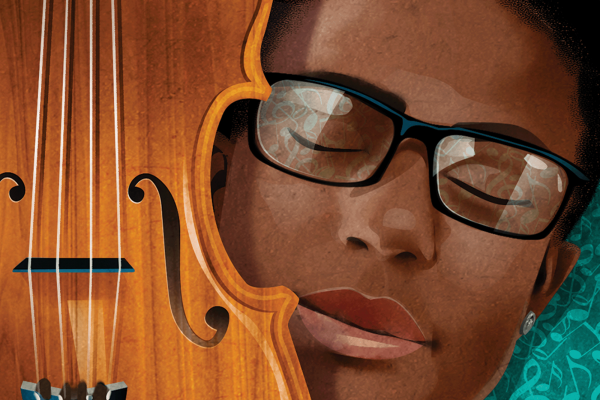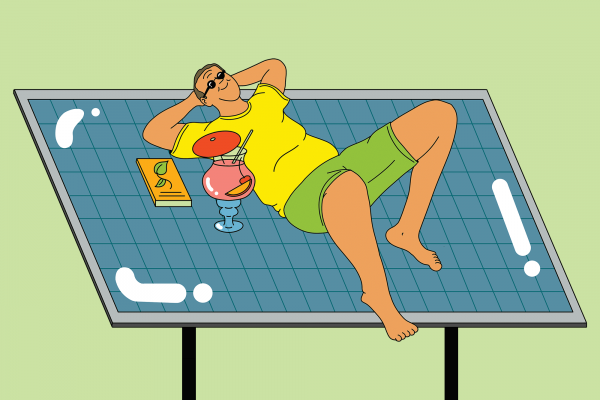The word “monster” originates with the Latin words for “omen” or “warning.” The best monster stories teach us about ourselves — about the evil that lurks in our own spirits. That’s something horror stories and the Enneagram have in common. The Enneagram is a system of personality typing and a tool for spiritual growth. As Enneagram teacher Ian Morgan Cron says, “Personality tools want to tell us who we really are. The Enneagram wants to tell us who we’re really not.” Unlike a strength or personality type, which help us see something true about ourselves — I’m an extrovert or an activator — the nine numbers (or enneatypes) point to personas we develop early in life. Some Enneagram experts see enneatypes as gifts with accompanying compulsions. Others understand our enneatypes as our false selves — personas that exist for the express purpose of protecting our true selves from a dangerous world.
One of the reasons monsters scare us is because we see our own darkness reflected in their eyes. The Enneagram can shine a light on the most monstrous parts of ourselves. This tour of horror movie monsters takes a stab at matching them to their Enneagram numbers. Maybe the fun-house reflections we see in them will spur us along the path to healing. A commitment to long-term inner-self work isn’t sexy enough for a Hollywood third act, but it does have a significantly lower body count.
Without further ado, let’s meet the monsters:
The One: John Kramer aka The Jigsaw Killer (Saw franchise)
“The truth will set you free.” -John Kramer
John Kramer, who has terminal cancer, is bitter at a world full of people who don’t appreciate the life they have. His anger manifests as diabolical traps that require some kind of sacrifice from their victims. In the first Saw film, for instance, Jigsaw puts Amanda, who is addicted to heroin, into a helmet attached to her jaws. The helmet is a “reverse bear trap” that, should she not find the key in time, will kill her. Jigsaw ultimately wants his victims to be grateful for every moment of their lives. His work follows a strict ethic that has no relationship with what’s legal or not. It's Jigsaw’s moral compass that rules the day.
Healing for Ones:
Ones reserve their harshest criticism for themselves, and this is certainly true of Kramer. If he worked harder to forgive himself instead of punishing the world around him, he could face his final days with peace.
Ones, silence that inner critic (let’s call them “Jigsaw”?). They’re wrong about you, and they’re wrong about the world around you. Give them a silly name or write down what they say about you and read it aloud. Get what’s inside you out so you can heal. Without deathtraps.
The Two: Annie Wilkes (Misery)
“We’re put on this earth to help people, Paul. Like I’m trying to help you.” -Annie Wilkes
Annie Wilkes is a nurse who gets the opportunity of a lifetime: Her favorite author crashes his car near her home, and she nurses him back to health. When she learns Paul has killed her favorite character in his latest novel, and plans to publish “more literary” books, Annie feels betrayed. She pleads with, manipulates, and ultimately tortures Paul until he agrees to resurrect her beloved franchise.
Healing for Twos:
Twos keep the world running — where would the rest of us be without their consistent, faithful presence? Twos need to know they’re not loved because of what they do for us, but just for who they are — warts and all.
Twos, learn to help with no strings (or sledgehammers!) attached. Make it a point this week to do your helping in secret; if the person you help knows it’s you, it doesn’t count.
The Three: Freddy Krueger (A Nightmare on Elm Street franchise)
“Being dead wasn’t a problem, but being forgotten, now that’s a b****!” -Freddy Krueger
Freddy Krueger haunts your dreams, and since he’s not bound by the laws of physics, he’s the consummate performer. Freddy doesn’t just kill the teens of Elm Street — he stages elaborate productions in your dreams. He gets his power from belief — since he’s already dead, the only way to truly get rid of him forever is to quit believing in him.
Healing for Threes:
Threes work so hard because they don’t feel inherently worthwhile. They’re convinced if they do enough, the world will love them. They’ll create an elaborate fantasy, lying even to themselves, if that’s what it takes to feel loved and accepted.
Threes: Learn to be, rather than do. Meditate on a scripture that affirms God’s love for you. Practice regular sabbath. You are not what you do, and the more often you can set aside your accomplishments, the more you can practice receiving love for who you are.
The Four: Pearl (X and Pearl)
“Seems like there’s something missing in me that the rest of the world has.” -Pearl
Pearl is a farm girl who knows she’s meant for more than a simple life. Between her secret theater-owner boyfriend and the approaching dance-tour audition, she’s sure she’s soon to leave small-town life in the rearview mirror. When things don’t go as planned, Pearl finds herself trapped on the farm, consigned to grow old in anonymity. Can you blame her for taking it out on those disrespectful kids who rent her farmhouse?
Healing for Fours:
No one will ever convince Pearl she doesn’t have what it takes to make it big — that would force her to confront her innate sense of inadequacy. Those who get too close find themselves on the wrong end of an axe (or alligator). So too, to compensate for their own secret shame, Fours spend a lot of time in a technicolor fantasy land, pining for a life so unrealistic they miss the good life they actually have in front of them.
Fours, practice looking for meaning in the ordinary. Train yourself to live in the here and now, and to love the mundane. (And maybe consider a less exotic pet than an alligator.)
The Five: Brundlefly (The Fly)
“I’m becoming Brundlefly. Don’t you think that’s worth a Nobel Prize or two?” -Seth Brundle
Seth Brundle is a brilliant scientist who invents teleportation. Unfortunately, when he tests his invention on himself, a fly joins him for the trip, fusing their DNA. Brundle’s devolution into Brundlefly is initially thrilling — super strength and acrobatic abilities impress his new girlfriend, Ronnie. But then he starts vomiting on his food. He pushes Ronnie away, unable to feel human emotion and rejecting even the possibility of help from any quarter.
Healing for Fives:
Fives value autonomy — they stockpile resources both physical and spiritual to ensure they don’t need anyone else. Nothing frightens Fives more than the possibility they may have to rely on someone else. No wonder that, by the end of the film, the Brundlefly wanted to repeat his ill-fated experiment to fuse himself with Ronnie, absorbing her into his self — and under his control.
Fives, you are natural contemplatives — but you know how easily that can become detachment. Do something to connect yourself with your body. Take a trip somewhere you’ve never been or drop in on a yoga class. Share something that makes you feel vulnerable with a friend.
The Six: Leatherface (The Texas Chainsaw Massacre franchise)
“I just can’t take no pleasure in killing. There’s just some things you gotta do. Don’t mean you have to like it.” -the Old Man
I’m not advocating for pity for a chainsaw-wielding killer, but poor Leatherface just wants to be a good son, a meaningful contributor to his household. Unfortunately, when your household is a bunch of cannibals, that loyalty is misplaced. Those teenagers who invited themselves into his family house were definitely rude and disrespectful, but he probably didn’t need to kill them.
Healing for Sixes:
Sixes are incredibly loyal, which is scary in a world we’re told is overflowing with dangers. No wonder they keep their chainsaw close at hand — eliminating threats and feeding their family in one fell swoop.
Sixes, flex your trust muscle. Most people aren’t out to get you, so try receiving their praise without suspicion (no, calling you “Leatherface” is not a compliment). Train yourself to recognize the difference between a legitimate fear and general anxiety. They don’t merit equivalent responses.
The Seven: Pinhead and the Cenobites (Hellraiser franchise)
“We have such sights to show you!” -Pinhead
Pinhead used to be human. He and his fellow Cenobites were consumed with the pursuit of pleasure — so much so that they lost the ability to distinguish it from pain. Now they seek out other hedonistic humans to invite them into an eternity of new experiences — which is a fun way to say “torture.”
Healing for Sevens:
Sevens are the unquestioned life of the party, but their boundless enthusiasm can be painful for the rest of us. Sevens, I promise: Too much of a good thing really is too much for the rest of us. We need to be able to feel those “bad” emotions — and you do too.
Sevens, make a commitment to be present to a friend who’s having a hard time. You don’t have to say anything. Resist your urge to cheer them up; just feel those hard feelings with them.
The Eight: Samara (The Ring franchise)
“Everyone will suffer.” -Samara
Samara didn’t have an easy childhood. Her adopted father never wanted her, and that caused a rift between him and her adopted mother — a rift that drove them to (checks notes) kill Samara and hide her body in a well?! No wonder Samara is angry at the world. Her experimental student film is her way of punishing everyone, seven days at a time. It’s safe to say she puts the “DIE” in director.
Healing for Eights:
Eights are fierce protectors. They’re the first people in the room to speak out against injustice. They see the world as a dangerous place, full of betrayal. And it’s true — bad things happen, but not nearly as often as Eights think.
Eights, practice vulnerability. That takes a lot of courage (so you may need to edit your definition of “courage”). And remember: What feels like passion to you feels like anger to a lot of other people. Try to learn what it feels like to be on the receiving end of you. One last thing — quit crawling out of TVs. It’s creepy and no one likes it.
The Nine: the Thing (The Thing, 1982)
“It’ll fight if it has to ... If it takes us over, then it has no more enemies, nobody left to kill it. And then it’s won.” -MacReady
The Thing didn’t ask to be here (we’re not entirely certain it can ask). It knows there’s quite a lot of office drama in the Arctic Research Station where it’s found refuge from the cold. But this shapeshifter doesn’t want to get involved. It wants to hang out with the dogs and be left alone. It’s not until you corner the Thing that it explodes and then, really, can you say it’s responsible for what happens next?
Healing for Nines:
How can the enneatype known as the Peacemaker possibly be a monster? What’s so bad about wanting everyone to get along? But Nines avoid every kind of conflict — even the healthy kind. They’ve so suppressed their own wants and desires that they merge with whoever happens to be in the room. But all those emotions don’t just vanish; they get stuffed down, down, down until Nines are a pressure cooker waiting to burst.
Nines, learn to value difference — including your own! Your desire for harmony so easily turns into a quest for unison. Ask yourself, “What do I want?” regularly — it’s going to be hard to answer at first. Find a friend you can trust who will help you discern what you really want (not just tell you to do what they want).
Got something to say about what you're reading? We value your feedback!







